TOPIC III. THE ORIGIN OF ENGLISH WORDS



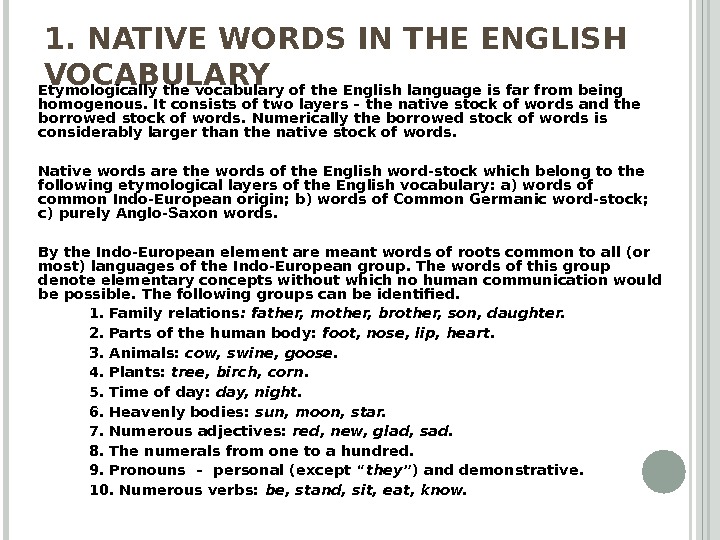

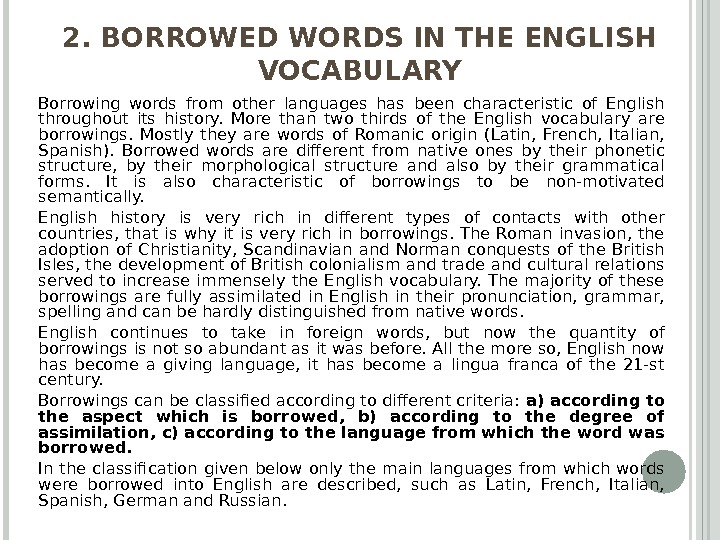
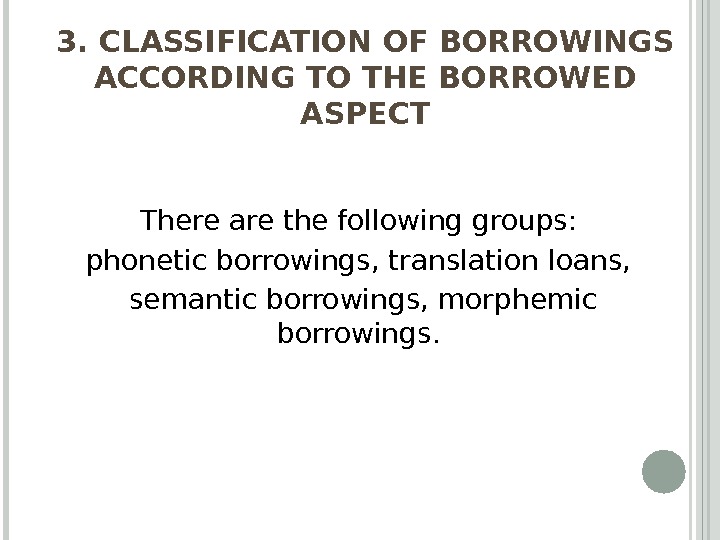
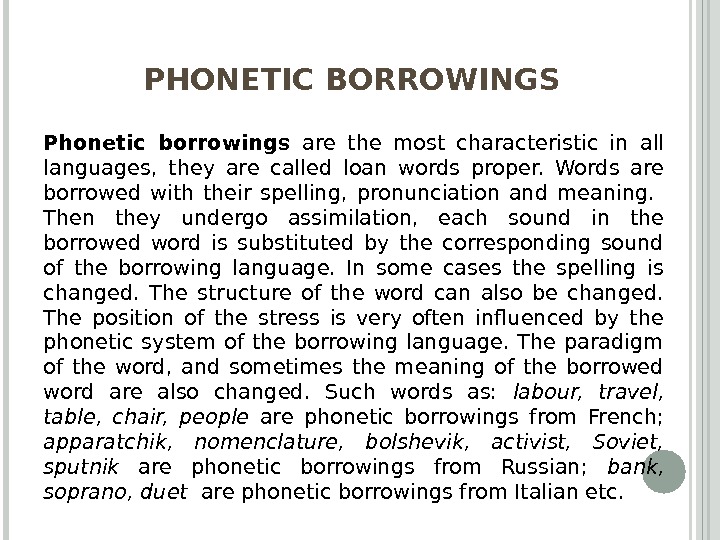
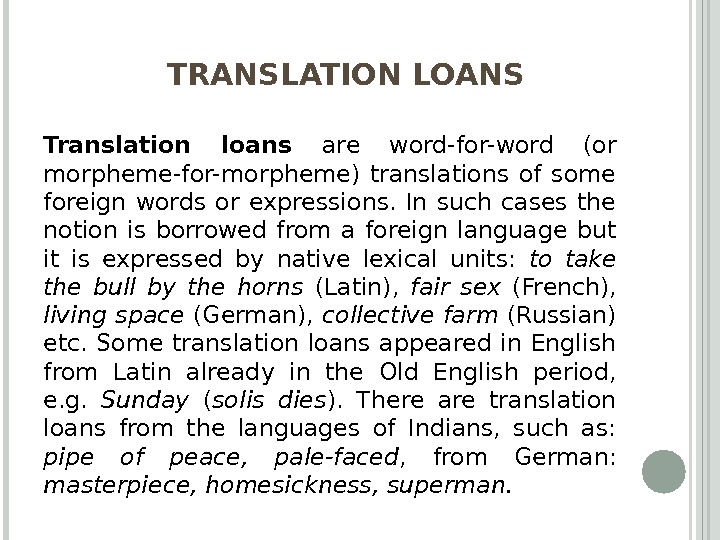




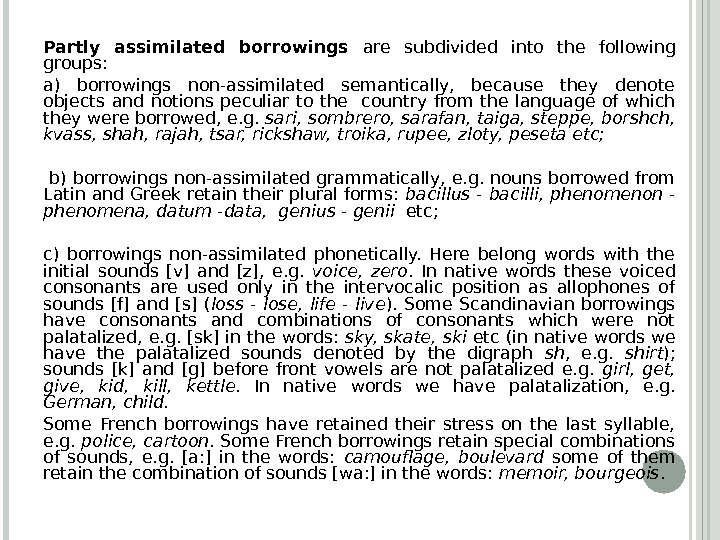
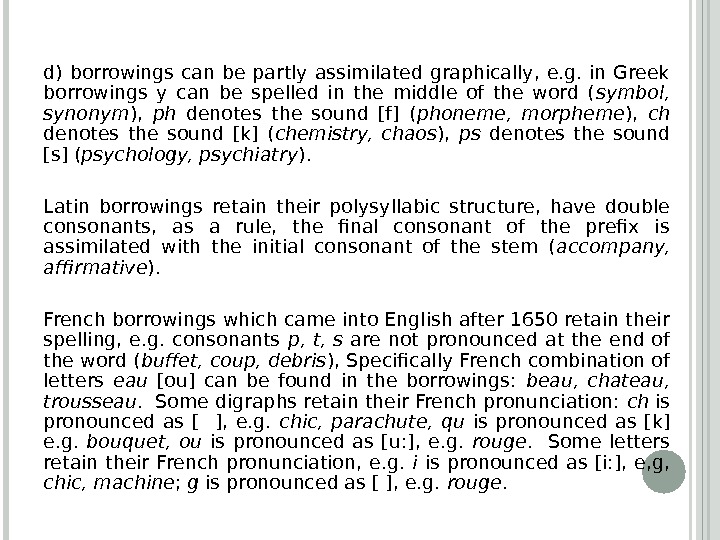









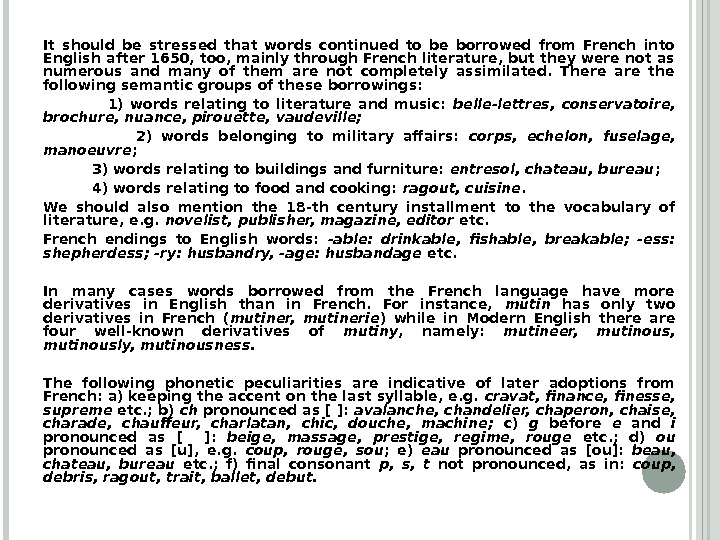




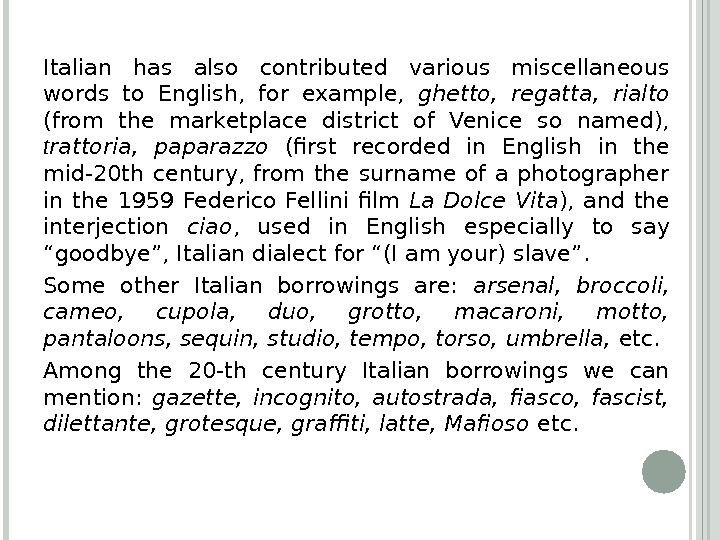


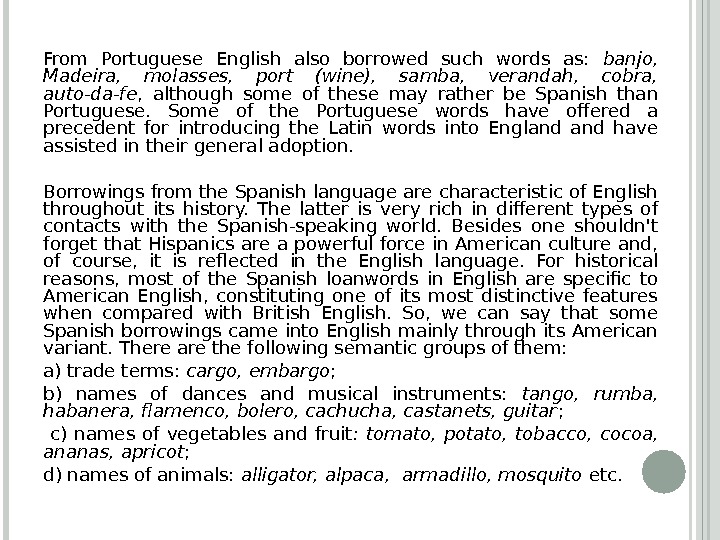


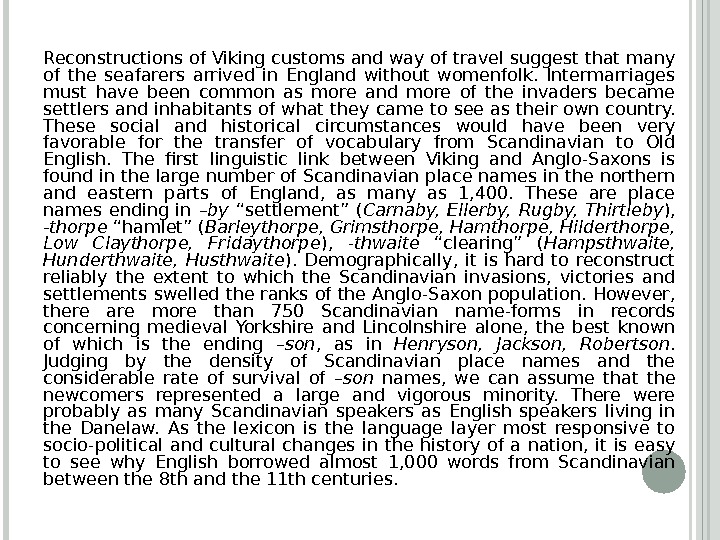
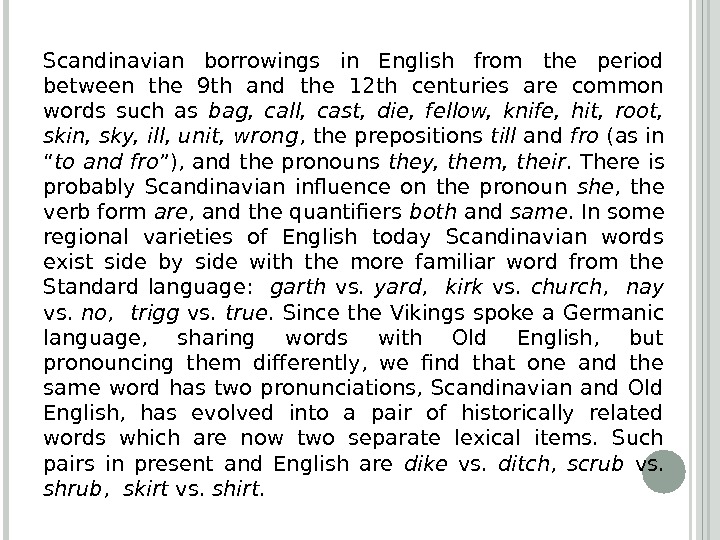

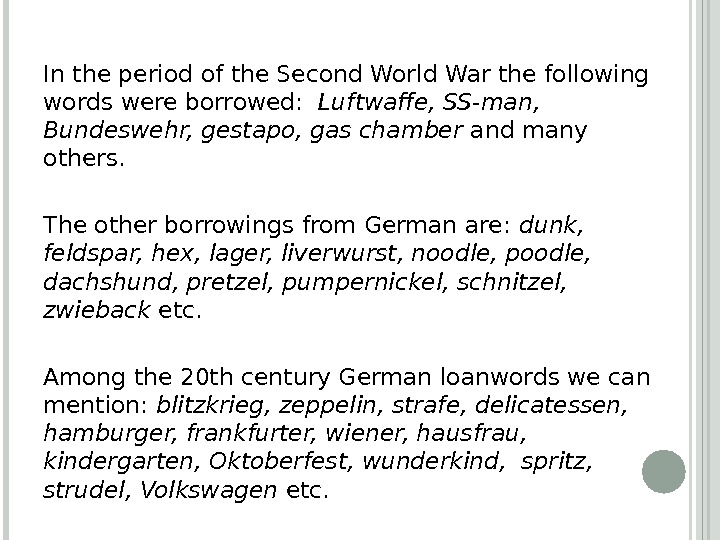
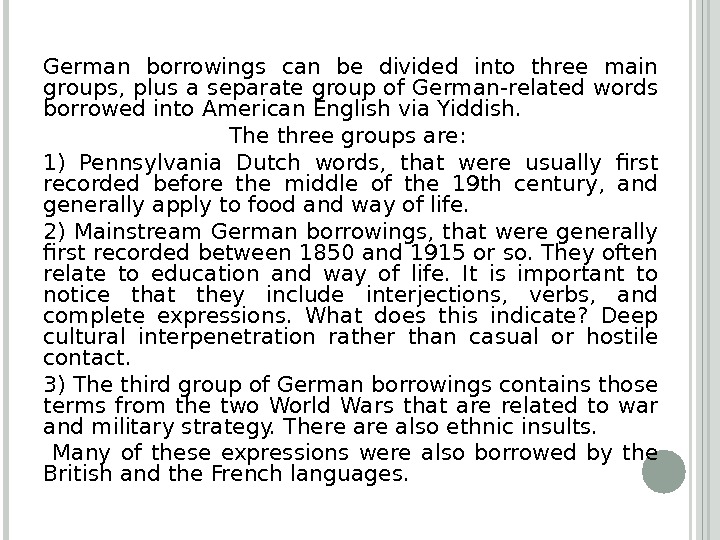
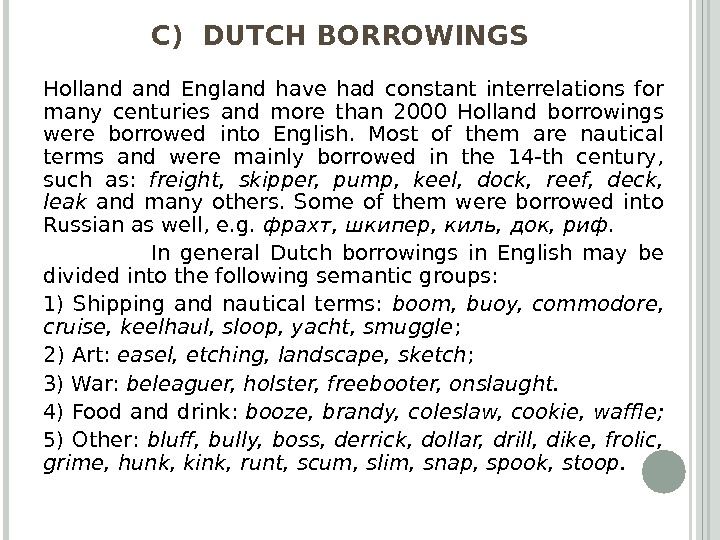


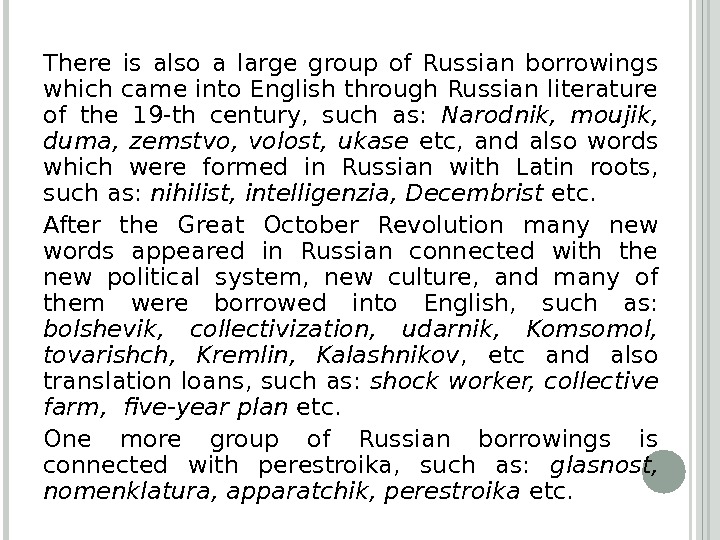


- Размер: 703 Кб
- Количество слайдов: 45
Описание презентации TOPIC III. THE ORIGIN OF ENGLISH WORDS по слайдам
 TOPIC III. THE ORIGIN OF ENGLISH WORDS
TOPIC III. THE ORIGIN OF ENGLISH WORDS
 PLAN 1. Native words in the English vocabulary 2. Borrowed words in the English vocabulary 3. Classification of borrowings according to the borrowed aspect 4. Classification of borrowings according to the degree of assimilation 5. Classification of borrowings according to the language from which they were borrowed: a) Romanic borrowings; b) Germanic borrowings; c) Slavic borrowings
PLAN 1. Native words in the English vocabulary 2. Borrowed words in the English vocabulary 3. Classification of borrowings according to the borrowed aspect 4. Classification of borrowings according to the degree of assimilation 5. Classification of borrowings according to the language from which they were borrowed: a) Romanic borrowings; b) Germanic borrowings; c) Slavic borrowings
 1. NATIVE WORDS IN THE ENGLISH VOCABULARY Etymologically the vocabulary of the English language is far from being homogenous. It consists of two layers – the native stock of words and the borrowed stock of words. Numerically the borrowed stock of words is considerably larger than the native stock of words. Native words are the words of the English word-stock which belong to the following etymological layers of the English vocabulary: a) words of common Indo-European origin; b) words of Common Germanic word-stock; c) purely Anglo-Saxon words. By the Indo-European element are meant words of roots common to all (or most) languages of the Indo-European group. The words of this group denote elementary concepts without which no human communication would be possible. The following groups can be identified. 1. Family relations : father, mother, brother, son, daughter. 2. Parts of the human body: foot, nose, lip, heart. 3. Animals: cow, swine, goose. 4. Plants: tree, birch, corn. 5. Time of day: day, night. 6. Heavenly bodies: sun, moon, star. 7. Numerous adjectives: red, new, glad, sad. 8. The numerals from one to a hundred. 9. Pronouns – personal (except “ they ”) and demonstrative. 10. Numerous verbs: be, stand, sit, eat, know.
1. NATIVE WORDS IN THE ENGLISH VOCABULARY Etymologically the vocabulary of the English language is far from being homogenous. It consists of two layers – the native stock of words and the borrowed stock of words. Numerically the borrowed stock of words is considerably larger than the native stock of words. Native words are the words of the English word-stock which belong to the following etymological layers of the English vocabulary: a) words of common Indo-European origin; b) words of Common Germanic word-stock; c) purely Anglo-Saxon words. By the Indo-European element are meant words of roots common to all (or most) languages of the Indo-European group. The words of this group denote elementary concepts without which no human communication would be possible. The following groups can be identified. 1. Family relations : father, mother, brother, son, daughter. 2. Parts of the human body: foot, nose, lip, heart. 3. Animals: cow, swine, goose. 4. Plants: tree, birch, corn. 5. Time of day: day, night. 6. Heavenly bodies: sun, moon, star. 7. Numerous adjectives: red, new, glad, sad. 8. The numerals from one to a hundred. 9. Pronouns – personal (except “ they ”) and demonstrative. 10. Numerous verbs: be, stand, sit, eat, know.
 The Germanic element represents words of roots common to all or most Germanic languages. Some of the main groups of Germanic words are the same as in the Indo-European element. 1. Parts of the human body: head, hand, arm, finger, bone. 2. Animals: bear, fox, calf. 3. Plants: oak, fir, grass 4. Natural phenomena: rain, frost. 5. Seasons of the year: winter, spring, summer. 6. Landscape features: sea, land. 7. Human dwellings and furniture: house, room, bench. 8. Sea-going vessels: boat, ship. 9. Adjectives: green, blue, grey, white, small, thick, high, old, good. 10. Verbs: see, hear, speak, tell, say, answer, make, give, drink. The English proper element is opposed to the first two groups. For not only it can be approximately dated, but these words have another distinctive feature: they are specifically English have no cognates in other languages whereas for Indo-European and Germanic words such cognates can always be found, as, for instance, for the following words of the Indo-European group. Star: Germ. – Stern, Lat. – Stella, Gr. – aster. Stand: Germ. – stehen, Lat. – stare, R. – стоять. Here are some examples of English proper words: bird, boy, girl, lord, lady, woman, daisy, always.
The Germanic element represents words of roots common to all or most Germanic languages. Some of the main groups of Germanic words are the same as in the Indo-European element. 1. Parts of the human body: head, hand, arm, finger, bone. 2. Animals: bear, fox, calf. 3. Plants: oak, fir, grass 4. Natural phenomena: rain, frost. 5. Seasons of the year: winter, spring, summer. 6. Landscape features: sea, land. 7. Human dwellings and furniture: house, room, bench. 8. Sea-going vessels: boat, ship. 9. Adjectives: green, blue, grey, white, small, thick, high, old, good. 10. Verbs: see, hear, speak, tell, say, answer, make, give, drink. The English proper element is opposed to the first two groups. For not only it can be approximately dated, but these words have another distinctive feature: they are specifically English have no cognates in other languages whereas for Indo-European and Germanic words such cognates can always be found, as, for instance, for the following words of the Indo-European group. Star: Germ. – Stern, Lat. – Stella, Gr. – aster. Stand: Germ. – stehen, Lat. – stare, R. – стоять. Here are some examples of English proper words: bird, boy, girl, lord, lady, woman, daisy, always.
 2. BORROWED WORDS IN THE ENGLISH VOCABULARY Borrowing words from other languages has been characteristic of English throughout its history. More than two thirds of the English vocabulary are borrowings. Mostly they are words of Romanic origin (Latin, French, Italian, Spanish). Borrowed words are different from native ones by their phonetic structure, by their morphological structure and also by their grammatical forms. It is also characteristic of borrowings to be non-motivated semantically. English history is very rich in different types of contacts with other countries, that is why it is very rich in borrowings. The Roman invasion, the adoption of Christianity, Scandinavian and Norman conquests of the British Isles, the development of British colonialism and trade and cultural relations served to increase immensely the English vocabulary. The majority of these borrowings are fully assimilated in English in their pronunciation, grammar, spelling and can be hardly distinguished from native words. English continues to take in foreign words, but now the quantity of borrowings is not so abundant as it was before. All the more so, English now has become a giving language, it has become a lingua franca of the 21 -st century. Borrowings can be classified according to different criteria: a) according to the aspect which is borrowed, b) according to the degree of assimilation, c) according to the language from which the word was borrowed. In the classification given below only the main languages from which words were borrowed into English are described, such as Latin, French, Italian, Spanish, German and Russian.
2. BORROWED WORDS IN THE ENGLISH VOCABULARY Borrowing words from other languages has been characteristic of English throughout its history. More than two thirds of the English vocabulary are borrowings. Mostly they are words of Romanic origin (Latin, French, Italian, Spanish). Borrowed words are different from native ones by their phonetic structure, by their morphological structure and also by their grammatical forms. It is also characteristic of borrowings to be non-motivated semantically. English history is very rich in different types of contacts with other countries, that is why it is very rich in borrowings. The Roman invasion, the adoption of Christianity, Scandinavian and Norman conquests of the British Isles, the development of British colonialism and trade and cultural relations served to increase immensely the English vocabulary. The majority of these borrowings are fully assimilated in English in their pronunciation, grammar, spelling and can be hardly distinguished from native words. English continues to take in foreign words, but now the quantity of borrowings is not so abundant as it was before. All the more so, English now has become a giving language, it has become a lingua franca of the 21 -st century. Borrowings can be classified according to different criteria: a) according to the aspect which is borrowed, b) according to the degree of assimilation, c) according to the language from which the word was borrowed. In the classification given below only the main languages from which words were borrowed into English are described, such as Latin, French, Italian, Spanish, German and Russian.
 3. CLASSIFICATION OF BORROWINGS ACCORDING TO THE BORROWED ASPECT There are the following groups: phonetic borrowings, translation loans, semantic borrowings, morphemic borrowings.
3. CLASSIFICATION OF BORROWINGS ACCORDING TO THE BORROWED ASPECT There are the following groups: phonetic borrowings, translation loans, semantic borrowings, morphemic borrowings.
 PHONETIC BORROWINGS Phonetic borrowings are the most characteristic in all languages, they are called loan words proper. Words are borrowed with their spelling, pronunciation and meaning. Then they undergo assimilation, each sound in the borrowed word is substituted by the corresponding sound of the borrowing language. In some cases the spelling is changed. The structure of the word can also be changed. The position of the stress is very often influenced by the phonetic system of the borrowing language. The paradigm of the word, and sometimes the meaning of the borrowed word are also changed. Such words as: labour, travel, table, chair, people are phonetic borrowings from French; apparatchik, nomenclature, bolshevik, activist, Soviet, sputnik are phonetic borrowings from Russian; bank, soprano, duet are phonetic borrowings from Italian etc.
PHONETIC BORROWINGS Phonetic borrowings are the most characteristic in all languages, they are called loan words proper. Words are borrowed with their spelling, pronunciation and meaning. Then they undergo assimilation, each sound in the borrowed word is substituted by the corresponding sound of the borrowing language. In some cases the spelling is changed. The structure of the word can also be changed. The position of the stress is very often influenced by the phonetic system of the borrowing language. The paradigm of the word, and sometimes the meaning of the borrowed word are also changed. Such words as: labour, travel, table, chair, people are phonetic borrowings from French; apparatchik, nomenclature, bolshevik, activist, Soviet, sputnik are phonetic borrowings from Russian; bank, soprano, duet are phonetic borrowings from Italian etc.
 TRANSLATION LOANS Translation loans are word-for-word (or morpheme-for-morpheme) translations of some foreign words or expressions. In such cases the notion is borrowed from a foreign language but it is expressed by native lexical units: to take the bull by the horns (Latin), fair sex (French), living space (German), collective farm (Russian) etc. Some translation loans appeared in English from Latin already in the Old English period, e. g. Sunday ( solis dies ). There are translation loans from the languages of Indians, such as: pipe of peace, pale-faced , from German: masterpiece, homesickness, superman.
TRANSLATION LOANS Translation loans are word-for-word (or morpheme-for-morpheme) translations of some foreign words or expressions. In such cases the notion is borrowed from a foreign language but it is expressed by native lexical units: to take the bull by the horns (Latin), fair sex (French), living space (German), collective farm (Russian) etc. Some translation loans appeared in English from Latin already in the Old English period, e. g. Sunday ( solis dies ). There are translation loans from the languages of Indians, such as: pipe of peace, pale-faced , from German: masterpiece, homesickness, superman.
 SEMANTIC BORROWINGS Semantic borrowings are such units when a new meaning of the unit existing in the language is borrowed. It can happen when we have two relative languages which have common words with different meanings, e. g. there are semantic borrowings between Scandinavian and English, such as the meaning to liv e for the word to dwell which in Old English had the meaning to wander. Or else the meaning дар, подарок for the word gift which in Old English had the meaning выкуп за жену. Semantic borrowings can appear when an English word was borrowed into some other language, developed there a new meaning and this new meaning was borrowed back into English, e. g. brigade was borrowed into Russian and acquired the meaning a working collective, бригада. This meaning was borrowed back into English as a Russian borrowing. The same is true of the English word pioneer.
SEMANTIC BORROWINGS Semantic borrowings are such units when a new meaning of the unit existing in the language is borrowed. It can happen when we have two relative languages which have common words with different meanings, e. g. there are semantic borrowings between Scandinavian and English, such as the meaning to liv e for the word to dwell which in Old English had the meaning to wander. Or else the meaning дар, подарок for the word gift which in Old English had the meaning выкуп за жену. Semantic borrowings can appear when an English word was borrowed into some other language, developed there a new meaning and this new meaning was borrowed back into English, e. g. brigade was borrowed into Russian and acquired the meaning a working collective, бригада. This meaning was borrowed back into English as a Russian borrowing. The same is true of the English word pioneer.
 MORPHEMIC BORROWINGS Morphemic borrowings are borrowings of affixes which occur in the language when many words with identical affixes are borrowed from one language into another, so that the morphemic structure of borrowed words becomes familiar to the people speaking the borrowing language, e. g. we can find a lot of Romanic affixes in the English word-building system, that is why there a lot of words-hybrids in English where different morphemes have different origin, e. g. goddess (native root + Romanic suffix –ess ), beautiful (French root + English suffix –ful ), uneatable (English prefix un- + English root + Romanic suffix –able ) etc.
MORPHEMIC BORROWINGS Morphemic borrowings are borrowings of affixes which occur in the language when many words with identical affixes are borrowed from one language into another, so that the morphemic structure of borrowed words becomes familiar to the people speaking the borrowing language, e. g. we can find a lot of Romanic affixes in the English word-building system, that is why there a lot of words-hybrids in English where different morphemes have different origin, e. g. goddess (native root + Romanic suffix –ess ), beautiful (French root + English suffix –ful ), uneatable (English prefix un- + English root + Romanic suffix –able ) etc.
 4. CLASSIFICATION OF BORROWINGS ACCORDING TO THE DEGREE OF ASSIMILATION The degree of assimilation of borrowings depends on the following factors: a) from what group of languages the word was borrowed (if the word belongs to the same group of languages to which the borrowing language belongs it is assimilated easier), b) in what way the word is borrowed: orally or in the written form (words borrowed orally are assimilated quicker), c) how often the borrowing is used in the language (the greater the frequency of its usage, the quicker it is assimilated), d) how long the word lives in the language (the longer it lives, the more assimilated it is).
4. CLASSIFICATION OF BORROWINGS ACCORDING TO THE DEGREE OF ASSIMILATION The degree of assimilation of borrowings depends on the following factors: a) from what group of languages the word was borrowed (if the word belongs to the same group of languages to which the borrowing language belongs it is assimilated easier), b) in what way the word is borrowed: orally or in the written form (words borrowed orally are assimilated quicker), c) how often the borrowing is used in the language (the greater the frequency of its usage, the quicker it is assimilated), d) how long the word lives in the language (the longer it lives, the more assimilated it is).
 ACCORDINGLY BORROWINGS ARE SUBDIVIDED INTO: COMPLETELY ASSIMILATED, PARTLY ASSIMILATED AND NON-ASSIMILATED (BARBARISMS). Completely assimilated borrowings are not felt as foreign words in the language, c. f. the French word sport and the native word start. Completely assimilated verbs belong to regular verbs, e. g. correct — corrected. Completely assimilated nouns form their plural by means of s-inflexion, e. g. gate — gates. In completely assimilated French words the stress has been shifted from the last syllable to the first one, e. g. capital, service. Semantic assimilation of borrowed words depends on the words existing in the borrowing language. As a rule, a borrowed word does not bring all its meanings into the borrowing language if it is polysemantic, e. g. the Russian borrowing sputnik is used in English only in one of its meanings.
ACCORDINGLY BORROWINGS ARE SUBDIVIDED INTO: COMPLETELY ASSIMILATED, PARTLY ASSIMILATED AND NON-ASSIMILATED (BARBARISMS). Completely assimilated borrowings are not felt as foreign words in the language, c. f. the French word sport and the native word start. Completely assimilated verbs belong to regular verbs, e. g. correct — corrected. Completely assimilated nouns form their plural by means of s-inflexion, e. g. gate — gates. In completely assimilated French words the stress has been shifted from the last syllable to the first one, e. g. capital, service. Semantic assimilation of borrowed words depends on the words existing in the borrowing language. As a rule, a borrowed word does not bring all its meanings into the borrowing language if it is polysemantic, e. g. the Russian borrowing sputnik is used in English only in one of its meanings.
 Partly assimilated borrowings are subdivided into the following groups: a) borrowings non-assimilated semantically, because they denote objects and notions peculiar to the country from the language of which they were borrowed, e. g. sari, sombrero, sarafan, taiga, steppe, borshch, kvass, shah, rajah, tsar, rickshaw, troika, rupee, zloty, peseta etc; b) borrowings non-assimilated grammatically, e. g. nouns borrowed from Latin and Greek retain their plural forms: bacillus — bacilli, phenomenon — phenomena, datum -data, genius — genii etc; c) borrowings non-assimilated phonetically. Here belong words with the initial sounds [v] and [z], e. g. voice, zero. In native words these voiced consonants are used only in the intervocalic position as allophones of sounds [f] and [s] ( loss — lose, life — live ). Some Scandinavian borrowings have consonants and combinations of consonants which were not palatalized, e. g. [sk] in the words: sky, skate, ski etc (in native words we have the palatalized sounds denoted by the digraph sh , e. g. shirt ); sounds [k] and [g] before front vowels are not palatalized e. g. girl, get, give, kid, kill, kettle. In native words we have palatalization, e. g. German, child. Some French borrowings have retained their stress on the last syllable, e. g. police, cartoon. Some French borrowings retain special combinations of sounds, e. g. [a: ] in the words: camouflage, boulevard some of them retain the combination of sounds [wa: ] in the words: memoir, bourgeois.
Partly assimilated borrowings are subdivided into the following groups: a) borrowings non-assimilated semantically, because they denote objects and notions peculiar to the country from the language of which they were borrowed, e. g. sari, sombrero, sarafan, taiga, steppe, borshch, kvass, shah, rajah, tsar, rickshaw, troika, rupee, zloty, peseta etc; b) borrowings non-assimilated grammatically, e. g. nouns borrowed from Latin and Greek retain their plural forms: bacillus — bacilli, phenomenon — phenomena, datum -data, genius — genii etc; c) borrowings non-assimilated phonetically. Here belong words with the initial sounds [v] and [z], e. g. voice, zero. In native words these voiced consonants are used only in the intervocalic position as allophones of sounds [f] and [s] ( loss — lose, life — live ). Some Scandinavian borrowings have consonants and combinations of consonants which were not palatalized, e. g. [sk] in the words: sky, skate, ski etc (in native words we have the palatalized sounds denoted by the digraph sh , e. g. shirt ); sounds [k] and [g] before front vowels are not palatalized e. g. girl, get, give, kid, kill, kettle. In native words we have palatalization, e. g. German, child. Some French borrowings have retained their stress on the last syllable, e. g. police, cartoon. Some French borrowings retain special combinations of sounds, e. g. [a: ] in the words: camouflage, boulevard some of them retain the combination of sounds [wa: ] in the words: memoir, bourgeois.
 d) borrowings can be partly assimilated graphically, e. g. in Greek borrowings y can be spelled in the middle of the word ( symbol, synonym ), ph denotes the sound [f] ( phoneme, morpheme ), ch denotes the sound [k] ( chemistry, chaos ), ps denotes the sound [s] ( psychology, psychiatry ). Latin borrowings retain their polysyllabic structure, have double consonants, as a rule, the final consonant of the prefix is assimilated with the initial consonant of the stem ( accompany, affirmative ). French borrowings which came into English after 1650 retain their spelling, e. g. consonants p, t, s are not pronounced at the end of the word ( buffet, coup, debris ), Specifically French combination of letters eau [ou] can be found in the borrowings: beau, chateau, trousseau. Some digraphs retain their French pronunciation: ch is pronounced as [ ], e. g. chic, parachute, qu is pronounced as [k] e. g. bouquet, ou is pronounced as [u: ], e. g. rouge. Some letters retain their French pronunciation, e. g. i is pronounced as [i: ], e, g, chic, machine ; g is pronounced as [ ], e. g. rouge.
d) borrowings can be partly assimilated graphically, e. g. in Greek borrowings y can be spelled in the middle of the word ( symbol, synonym ), ph denotes the sound [f] ( phoneme, morpheme ), ch denotes the sound [k] ( chemistry, chaos ), ps denotes the sound [s] ( psychology, psychiatry ). Latin borrowings retain their polysyllabic structure, have double consonants, as a rule, the final consonant of the prefix is assimilated with the initial consonant of the stem ( accompany, affirmative ). French borrowings which came into English after 1650 retain their spelling, e. g. consonants p, t, s are not pronounced at the end of the word ( buffet, coup, debris ), Specifically French combination of letters eau [ou] can be found in the borrowings: beau, chateau, trousseau. Some digraphs retain their French pronunciation: ch is pronounced as [ ], e. g. chic, parachute, qu is pronounced as [k] e. g. bouquet, ou is pronounced as [u: ], e. g. rouge. Some letters retain their French pronunciation, e. g. i is pronounced as [i: ], e, g, chic, machine ; g is pronounced as [ ], e. g. rouge.
 Modern German borrowings also have some peculiarities in their spelling: common nouns are spelled with a capital letter e. g. Autobahn, Lebensraum , some vowels and digraphs retain their German pronunciation, e. g. a is pronounced as [a: ], e. g. Dictat , u is pronounced as [u: ], e. g. Kuchen , au is pronounced as [au], e. g. Hausfrau , ei is pronounced as [ai], e. g. Reich. Some consonants are also pronounced in the German way, e. g. s before a vowel is pronounced as [z], e. g. Sitskrieg , v is pronounced as [f], e. g. Volkswagen , w is pronounced as [v], ch is pronounced as [h], e. g. Kuchen.
Modern German borrowings also have some peculiarities in their spelling: common nouns are spelled with a capital letter e. g. Autobahn, Lebensraum , some vowels and digraphs retain their German pronunciation, e. g. a is pronounced as [a: ], e. g. Dictat , u is pronounced as [u: ], e. g. Kuchen , au is pronounced as [au], e. g. Hausfrau , ei is pronounced as [ai], e. g. Reich. Some consonants are also pronounced in the German way, e. g. s before a vowel is pronounced as [z], e. g. Sitskrieg , v is pronounced as [f], e. g. Volkswagen , w is pronounced as [v], ch is pronounced as [h], e. g. Kuchen.
 NON-ASSIMILATED BORROWINGS Non-assimilated borrowings (barbarisms) are borrowings which are used by Englishmen rather seldom and are non-assimilated, e. g. addio (Italian), tete-a-tete (French), dolce vita (Italian), duende (Spanish), an homme, a femme (French), gonzo, ciao (Italian) and many others.
NON-ASSIMILATED BORROWINGS Non-assimilated borrowings (barbarisms) are borrowings which are used by Englishmen rather seldom and are non-assimilated, e. g. addio (Italian), tete-a-tete (French), dolce vita (Italian), duende (Spanish), an homme, a femme (French), gonzo, ciao (Italian) and many others.
 5. CLASSIFICATION OF BORROWINGS ACCORDING TO THE LANGUAGE FROM WHICH THEY WERE BORROWED I. Romanic borrowings in the English vocabulary a) Latin and Greek borrowings Among words of Romanic origin borrowed from Latin during the period when the British Isles were a part of the Roman Empire, there are such words as: street, port, wall etc. Many Latin and Greek words came into English during the Adoption of Christianity in the 6 -th century. At this time the Latin alphabet was borrowed which ousted the Runic alphabet. These borrowings are usually called classical borrowings. Here belong Latin words: alter, cross, dean, and Greek words: church, angel, devil, anthem.
5. CLASSIFICATION OF BORROWINGS ACCORDING TO THE LANGUAGE FROM WHICH THEY WERE BORROWED I. Romanic borrowings in the English vocabulary a) Latin and Greek borrowings Among words of Romanic origin borrowed from Latin during the period when the British Isles were a part of the Roman Empire, there are such words as: street, port, wall etc. Many Latin and Greek words came into English during the Adoption of Christianity in the 6 -th century. At this time the Latin alphabet was borrowed which ousted the Runic alphabet. These borrowings are usually called classical borrowings. Here belong Latin words: alter, cross, dean, and Greek words: church, angel, devil, anthem.
 Latin and Greek borrowings appeared in English during the Middle English period due to the Great Revival of Learning. These are mostly scientific words because Latin was the language of science at the time. These words were not used as frequently as the words of the Old English period, therefore some of them were partly assimilated grammatically, e. g. formula — formulae. Here also belong such words as: memorandum, minimum, maximum, veto etc. Classical borrowings continue to appear in Modern English as well. Mostly they are words formed with the help of Latin and Greek morphemes. There are quite a lot of them in medicine ( appendicitis, aspirin ), in chemistry (acid, valency, alkali) , in technique (engine, antenna, biplane, airdrome) , in politics (socialism, militarism) , names of sciences (zoology, physics). In philology most of terms are of Greek origin (homonym, archaism, lexicography).
Latin and Greek borrowings appeared in English during the Middle English period due to the Great Revival of Learning. These are mostly scientific words because Latin was the language of science at the time. These words were not used as frequently as the words of the Old English period, therefore some of them were partly assimilated grammatically, e. g. formula — formulae. Here also belong such words as: memorandum, minimum, maximum, veto etc. Classical borrowings continue to appear in Modern English as well. Mostly they are words formed with the help of Latin and Greek morphemes. There are quite a lot of them in medicine ( appendicitis, aspirin ), in chemistry (acid, valency, alkali) , in technique (engine, antenna, biplane, airdrome) , in politics (socialism, militarism) , names of sciences (zoology, physics). In philology most of terms are of Greek origin (homonym, archaism, lexicography).
 B) FRENCH BORROWINGS Norman-French borrowings had come into English at different times. The most important historical event which has left a lasting mark on the composition of the English lexicon is the Norman Conquest of Britain in 1066. In that year, William, Duke of Normandy, attacked and defeated the English army at Hastings on the south coast of England. He was then crowned king of England, replacing the Saxon line. By the end of the eleventh century the positions of influence, prestige, and learning in England were occupied by Norman nobility, churchmen, and clerics. The exact number of new settlers following the Conquest is unknown. The flooding of the English vocabulary with Norman-French words began in the 13 -th century and reached very large proportions in the century that followed. Norman-French loans in the English vocabulary may be subdivided into two main groups: 1) early loans – 12 – 15 th centuries; 2) later loans – beginning from the 16 th century.
B) FRENCH BORROWINGS Norman-French borrowings had come into English at different times. The most important historical event which has left a lasting mark on the composition of the English lexicon is the Norman Conquest of Britain in 1066. In that year, William, Duke of Normandy, attacked and defeated the English army at Hastings on the south coast of England. He was then crowned king of England, replacing the Saxon line. By the end of the eleventh century the positions of influence, prestige, and learning in England were occupied by Norman nobility, churchmen, and clerics. The exact number of new settlers following the Conquest is unknown. The flooding of the English vocabulary with Norman-French words began in the 13 -th century and reached very large proportions in the century that followed. Norman-French loans in the English vocabulary may be subdivided into two main groups: 1) early loans – 12 – 15 th centuries; 2) later loans – beginning from the 16 th century.
 Early French loans were thoroughly naturalized in English and made to conform to the rules of English pronunciation. The early borrowings from French were simple short words as distinguished from later introductions. This will be seen from an examination of the number of common monosyllabic words derived from early French, e. g. age, air, arm, bolt, brace, breeze, brush, cage, calm, cape, car, case, cause, cease, cell, chain, chance, chase, chief, chaise, claim, clear, close, corpse, court, crime, cry etc. All these words have become an integral part of the language, being as truly a part of common speech as words native by origin. They have been so assimilated in sound and inflection as to be recognized as foreign only to the eye of a philologist.
Early French loans were thoroughly naturalized in English and made to conform to the rules of English pronunciation. The early borrowings from French were simple short words as distinguished from later introductions. This will be seen from an examination of the number of common monosyllabic words derived from early French, e. g. age, air, arm, bolt, brace, breeze, brush, cage, calm, cape, car, case, cause, cease, cell, chain, chance, chase, chief, chaise, claim, clear, close, corpse, court, crime, cry etc. All these words have become an integral part of the language, being as truly a part of common speech as words native by origin. They have been so assimilated in sound and inflection as to be recognized as foreign only to the eye of a philologist.
 Examples of the naturalization of French words in English may be given in numbers. A few of them will suffice for illustration: a) words stressed in French on the final syllable are now stressed in English on the first syllable, e. g. capital, danger, final, mercy, probable , etc. ; b) words with the long [i: ] sound diphtongized into [ai], e. g. design, fine, lion, price ; c) the long [u: ] written ou has become [au], e. g. spouse. So, the unprecedented enrichment of the lexicon through borrowing altered the etymological composition of English after the conquest. Data on the exact number of words borrowed from French is difficult to obtain, but according to one estimate the number of French words adopted during the Middle English period was slightly over 10, 000. Of these, about 75 percent have survived and are still used in present-day English.
Examples of the naturalization of French words in English may be given in numbers. A few of them will suffice for illustration: a) words stressed in French on the final syllable are now stressed in English on the first syllable, e. g. capital, danger, final, mercy, probable , etc. ; b) words with the long [i: ] sound diphtongized into [ai], e. g. design, fine, lion, price ; c) the long [u: ] written ou has become [au], e. g. spouse. So, the unprecedented enrichment of the lexicon through borrowing altered the etymological composition of English after the conquest. Data on the exact number of words borrowed from French is difficult to obtain, but according to one estimate the number of French words adopted during the Middle English period was slightly over 10, 000. Of these, about 75 percent have survived and are still used in present-day English.
 The French dominance is particularly felt in the vocabulary of law. Most words pertaining to law are of French origin, e. g. accuse, attorney, court, defendant, fee, felony, guile, heritage, judge, justice, justify, penalty, plaintiff, privilege, session, suit, advocate, inquest, sentence, barrister etc. It was also natural that many of the terms relating to military matters should be adopted from the language of the conquerors, as, for instance, army, arms, admiral, assault, armor, banner, battle, dart, dragon, ensign, guard, lance, mail, navy, sergeant, soldier, troops, vessel, victory, war etc. There is a predominance of French words in the vocabulary of cookery, which is shown by a great many words, such as: lunch, dinner, appetite, to roast, to stew, to boil, to fry, dainty, jelly, pastry, sauce, sausage, soup, toast etc. We shall find a very large number of French words denoting different objects that make life enjoyable, e. g. comfort, flower, fruit, pleasure, feast, leisure, delight, ease etc.
The French dominance is particularly felt in the vocabulary of law. Most words pertaining to law are of French origin, e. g. accuse, attorney, court, defendant, fee, felony, guile, heritage, judge, justice, justify, penalty, plaintiff, privilege, session, suit, advocate, inquest, sentence, barrister etc. It was also natural that many of the terms relating to military matters should be adopted from the language of the conquerors, as, for instance, army, arms, admiral, assault, armor, banner, battle, dart, dragon, ensign, guard, lance, mail, navy, sergeant, soldier, troops, vessel, victory, war etc. There is a predominance of French words in the vocabulary of cookery, which is shown by a great many words, such as: lunch, dinner, appetite, to roast, to stew, to boil, to fry, dainty, jelly, pastry, sauce, sausage, soup, toast etc. We shall find a very large number of French words denoting different objects that make life enjoyable, e. g. comfort, flower, fruit, pleasure, feast, leisure, delight, ease etc.
 Among French borrowings there also such semantic groups of words: a) words denoting family relations: parent, cousin, uncle, aunt, nephew, niece ; b) words relating to fashion: luxury, coat, lace, pleat, embroidery ; c) words belonging to jewelry: topaz, emerald, pearl ; d) words relating to state government: administer, empire, state, government, realm, people, nation, crown, power, authority, parliament, council; e) words connected with the church: blame, lesson, pray, service, tempt etc. From the fifteenth century the importance of French loans decreased, while English turned increasingly towards Latin and Greek for new learned words. Scholarly and everyday words continued to be borrowed from French in the sixteenth century: fragrant, elegance, baton, accent, adverb, amplitude, cassock, chamois, demolish, pounce, admire, avenue etc.
Among French borrowings there also such semantic groups of words: a) words denoting family relations: parent, cousin, uncle, aunt, nephew, niece ; b) words relating to fashion: luxury, coat, lace, pleat, embroidery ; c) words belonging to jewelry: topaz, emerald, pearl ; d) words relating to state government: administer, empire, state, government, realm, people, nation, crown, power, authority, parliament, council; e) words connected with the church: blame, lesson, pray, service, tempt etc. From the fifteenth century the importance of French loans decreased, while English turned increasingly towards Latin and Greek for new learned words. Scholarly and everyday words continued to be borrowed from French in the sixteenth century: fragrant, elegance, baton, accent, adverb, amplitude, cassock, chamois, demolish, pounce, admire, avenue etc.
 It should be stressed that words continued to be borrowed from French into English after 1650, too, mainly through French literature, but they were not as numerous and many of them are not completely assimilated. There are the following semantic groups of these borrowings: 1) words relating to literature and music: belle-lettres, conservatoire, brochure, nuance, pirouette, vaudeville; 2) words belonging to military affairs: corps, echelon, fuselage, manoeuvre ; 3) words relating to buildings and furniture: entresol, chateau, bureau ; 4) words relating to food and cooking: ragout, cuisine. We should also mention the 18 -th century installment to the vocabulary of literature, e. g. novelist, publisher, magazine, editor etc. French endings to English words: -able: drinkable, fishable, breakable; -ess: shepherdess; -ry: husbandry, -age: husbandage etc. In many cases words borrowed from the French language have more derivatives in English than in French. For instance, mutin has only two derivatives in French ( mutiner, mutinerie ) while in Modern English there are four well-known derivatives of mutiny , namely: mutineer, mutinously, mutinousness. The following phonetic peculiarities are indicative of later adoptions from French: a) keeping the accent on the last syllable, e. g. cravat, finance, finesse, supreme etc. ; b) ch pronounced as [ ]: avalanche, chandelier, chaperon, chaise, charade, chauffeur, charlatan, chic, douche, machine; c) g before e and i pronounced as [ ]: beige, massage, prestige, regime, rouge etc. ; d) ou pronounced as [u], e. g. coup, rouge, sou ; e) eau pronounced as [ou]: beau, chateau, bureau etc. ; f) final consonant p, s, t not pronounced, as in: coup, debris, ragout, trait, ballet, debut.
It should be stressed that words continued to be borrowed from French into English after 1650, too, mainly through French literature, but they were not as numerous and many of them are not completely assimilated. There are the following semantic groups of these borrowings: 1) words relating to literature and music: belle-lettres, conservatoire, brochure, nuance, pirouette, vaudeville; 2) words belonging to military affairs: corps, echelon, fuselage, manoeuvre ; 3) words relating to buildings and furniture: entresol, chateau, bureau ; 4) words relating to food and cooking: ragout, cuisine. We should also mention the 18 -th century installment to the vocabulary of literature, e. g. novelist, publisher, magazine, editor etc. French endings to English words: -able: drinkable, fishable, breakable; -ess: shepherdess; -ry: husbandry, -age: husbandage etc. In many cases words borrowed from the French language have more derivatives in English than in French. For instance, mutin has only two derivatives in French ( mutiner, mutinerie ) while in Modern English there are four well-known derivatives of mutiny , namely: mutineer, mutinously, mutinousness. The following phonetic peculiarities are indicative of later adoptions from French: a) keeping the accent on the last syllable, e. g. cravat, finance, finesse, supreme etc. ; b) ch pronounced as [ ]: avalanche, chandelier, chaperon, chaise, charade, chauffeur, charlatan, chic, douche, machine; c) g before e and i pronounced as [ ]: beige, massage, prestige, regime, rouge etc. ; d) ou pronounced as [u], e. g. coup, rouge, sou ; e) eau pronounced as [ou]: beau, chateau, bureau etc. ; f) final consonant p, s, t not pronounced, as in: coup, debris, ragout, trait, ballet, debut.
 To sum it up, we can come to the conclusion that French borrowings which had come to the English language at different times constitute the largest group of borrowings. French loans in the English vocabulary may be subdivided into two main groups: 1) early loans – 12– 15 th centuries; 2) later loans – beginning from the 16 th century. It should be added that early loans are known as Norman French borrowings, because they were borrowed from Norman French (also known as Anglo-French or Anglo-Norman), which was one of the provincial dialects of the French language. But later loans are known as Parisian borrowings, because they were borrowed from the Parisian dialect of the French language.
To sum it up, we can come to the conclusion that French borrowings which had come to the English language at different times constitute the largest group of borrowings. French loans in the English vocabulary may be subdivided into two main groups: 1) early loans – 12– 15 th centuries; 2) later loans – beginning from the 16 th century. It should be added that early loans are known as Norman French borrowings, because they were borrowed from Norman French (also known as Anglo-French or Anglo-Norman), which was one of the provincial dialects of the French language. But later loans are known as Parisian borrowings, because they were borrowed from the Parisian dialect of the French language.
 C) ITALIAN BORROWINGS Cultural and trade relations between Italy and England brought many Italian words into English. The earliest Italian borrowing came into English in the 14 -th century, it was the word bank from the Italian banko – “bench”. Italian money-lenders and money-changers sat in the streets on benches. When they suffered losses they turned over their benches, it was called banco rotta from which the English word bankrupt originated. Italian was the source of many borrowed words in the English vocabulary at different periods. During the first two centuries of the Early Modern linguistic period (1476 -1776), the words borrowed from Italian were distributed evenly between words having to do with everyday life, military activities, architecture, and the arts. From that period English has inherited artichoke (1531), gondola (1549), squadron (1562), stanza (1588), fresco (1598), bazaar (1599), balcony (1619), opera (1644), vermicelli (1669), rotunda (1687) and others. In the 17 -th century some geological terms were borrowed from Italian into English: volcano, granite, bronze, lava. At the same time some political terms were borrowed from Italian, too: manifesto, bulletin.
C) ITALIAN BORROWINGS Cultural and trade relations between Italy and England brought many Italian words into English. The earliest Italian borrowing came into English in the 14 -th century, it was the word bank from the Italian banko – “bench”. Italian money-lenders and money-changers sat in the streets on benches. When they suffered losses they turned over their benches, it was called banco rotta from which the English word bankrupt originated. Italian was the source of many borrowed words in the English vocabulary at different periods. During the first two centuries of the Early Modern linguistic period (1476 -1776), the words borrowed from Italian were distributed evenly between words having to do with everyday life, military activities, architecture, and the arts. From that period English has inherited artichoke (1531), gondola (1549), squadron (1562), stanza (1588), fresco (1598), bazaar (1599), balcony (1619), opera (1644), vermicelli (1669), rotunda (1687) and others. In the 17 -th century some geological terms were borrowed from Italian into English: volcano, granite, bronze, lava. At the same time some political terms were borrowed from Italian, too: manifesto, bulletin.
 Italian is considered a very important contributor to English, especially to music, the other arts, and cuisine. At the beginning of the 18 -th century, Italian music and especially Italian opera became very fashionable in England, and with that came a new wave of Italian loanwords. Indeed, there was a real explosion of new musical words in English. Many music terms are direct borrowings from Italian, while others came into English via Italian from other languages. Here is a small selection of some of these words with their dates of entry (all dates from the Chronological English Dictionary): adagio (1746), allegretto (1740), andante (1742), bravo (1761), cantata (1724), coda (1753), coloratura (1753), concerto (1730), moderato (1724), pianissimo (1724), pianoforte (1767), sotto voce (1737), trombone (1724) etc. These words traverse the broad landscape of music, occupying numerous subcategories. A few representative examples are these: directions: agitato, grandioso, lentissimo, vivace ; composition: fugue, madrigal, capriccio, concerto, fantasia, intermezzo, opera, operetta, sonata, toccata, oratorio ; performers and singing-voice ranges: solo, duet, trio, quartet, quintet, sextet, septet, octet, nonet; baritone, tenor, falsetto, alto, basso, diva, contralto, soprano, mezzo-soprano, prima donna and musical instruments: ocarina, piano, timpani, violin, violoncello, viola, contrabass, harmonica, tuba, harpsichord, mandolin.
Italian is considered a very important contributor to English, especially to music, the other arts, and cuisine. At the beginning of the 18 -th century, Italian music and especially Italian opera became very fashionable in England, and with that came a new wave of Italian loanwords. Indeed, there was a real explosion of new musical words in English. Many music terms are direct borrowings from Italian, while others came into English via Italian from other languages. Here is a small selection of some of these words with their dates of entry (all dates from the Chronological English Dictionary): adagio (1746), allegretto (1740), andante (1742), bravo (1761), cantata (1724), coda (1753), coloratura (1753), concerto (1730), moderato (1724), pianissimo (1724), pianoforte (1767), sotto voce (1737), trombone (1724) etc. These words traverse the broad landscape of music, occupying numerous subcategories. A few representative examples are these: directions: agitato, grandioso, lentissimo, vivace ; composition: fugue, madrigal, capriccio, concerto, fantasia, intermezzo, opera, operetta, sonata, toccata, oratorio ; performers and singing-voice ranges: solo, duet, trio, quartet, quintet, sextet, septet, octet, nonet; baritone, tenor, falsetto, alto, basso, diva, contralto, soprano, mezzo-soprano, prima donna and musical instruments: ocarina, piano, timpani, violin, violoncello, viola, contrabass, harmonica, tuba, harpsichord, mandolin.
 The addition of the Italian musical terms to English illustrates well the importance of innovation, leadership, and prestige to the composition of the vocabulary. During the 18 -th century it became impossible to speak about western music in English without using an Italian word. It should be mentioned that half the Italian words in English, even those of modern times, have come through French. Many other Italian words introduced through French or adopted to French forms are: alarm, battalion, bankrupt, bastion, brusque, brigade, carat, colonel, cavalcade, campaign, charlatan, gala, gazette, grotesque, infantry, pistol, rebuff. To the other arts Italian has contributed words like fresco, tarantella, galleria, cameo and literati. To cuisine, Italian’s prolific contributions are evidenced by these representative examples: antipasto, cappuccino, espresso, maraschino, mozzarella, linguini, pasta (and the words for all its shapes and varieties), pizza, ravioli, spaghetti, spumante, spumoni and zucchini. The word tetrazzini , as in chicken tetrazzini , is an eponym based on the surname of the Italian opera diva Luisa Tetrazzini (1874 -1940).
The addition of the Italian musical terms to English illustrates well the importance of innovation, leadership, and prestige to the composition of the vocabulary. During the 18 -th century it became impossible to speak about western music in English without using an Italian word. It should be mentioned that half the Italian words in English, even those of modern times, have come through French. Many other Italian words introduced through French or adopted to French forms are: alarm, battalion, bankrupt, bastion, brusque, brigade, carat, colonel, cavalcade, campaign, charlatan, gala, gazette, grotesque, infantry, pistol, rebuff. To the other arts Italian has contributed words like fresco, tarantella, galleria, cameo and literati. To cuisine, Italian’s prolific contributions are evidenced by these representative examples: antipasto, cappuccino, espresso, maraschino, mozzarella, linguini, pasta (and the words for all its shapes and varieties), pizza, ravioli, spaghetti, spumante, spumoni and zucchini. The word tetrazzini , as in chicken tetrazzini , is an eponym based on the surname of the Italian opera diva Luisa Tetrazzini (1874 -1940).
 Italian has also contributed various miscellaneous words to English, for example, ghetto, regatta, rialto (from the marketplace district of Venice so named), t rattoria, paparazzo (first recorded in English in the mid-20 th century, from the surname of a photographer in the 1959 Federico Fellini film La Dolce Vita ), and the interjection ciao , used in English especially to say “goodbye”, Italian dialect for “(I am your) slave”. Some other Italian borrowings are: arsenal, broccoli, cameo, cupola, duo, grotto, macaroni, motto, pantaloons, sequin, studio, tempo, torso, umbrella, etc. Among the 20 -th century Italian borrowings we can mention: gazette, incognito, autostrada, fiasco, fascist, dilettante, grotesque, graffiti, latte, Mafioso etc.
Italian has also contributed various miscellaneous words to English, for example, ghetto, regatta, rialto (from the marketplace district of Venice so named), t rattoria, paparazzo (first recorded in English in the mid-20 th century, from the surname of a photographer in the 1959 Federico Fellini film La Dolce Vita ), and the interjection ciao , used in English especially to say “goodbye”, Italian dialect for “(I am your) slave”. Some other Italian borrowings are: arsenal, broccoli, cameo, cupola, duo, grotto, macaroni, motto, pantaloons, sequin, studio, tempo, torso, umbrella, etc. Among the 20 -th century Italian borrowings we can mention: gazette, incognito, autostrada, fiasco, fascist, dilettante, grotesque, graffiti, latte, Mafioso etc.
 D) SPANISH AND PORTUGUESE BORROWINGS Spanish and Portuguese borrowings reflect the cultural traditions and accomplishments and the naval and military exploits of the countries of origin. Spain and Portugal led Europe in the colonization of the New World, and some of the words borrowed from Spanish had been borrowed into English from American Indian languages. Spanish has made one of the major contributions to English vocabulary. Its influence began to be felt in the 16 -th century, at a time when Spain was a world power in conflict with the English Crown, and it gained new momentum when Spain set foot in America.
D) SPANISH AND PORTUGUESE BORROWINGS Spanish and Portuguese borrowings reflect the cultural traditions and accomplishments and the naval and military exploits of the countries of origin. Spain and Portugal led Europe in the colonization of the New World, and some of the words borrowed from Spanish had been borrowed into English from American Indian languages. Spanish has made one of the major contributions to English vocabulary. Its influence began to be felt in the 16 -th century, at a time when Spain was a world power in conflict with the English Crown, and it gained new momentum when Spain set foot in America.
 Early borrowings from Spanish include: armada (1530), guava (1555), hammock (1555), maize (1555), negro (1555), potato (1565), armadillo (1570), mestizo (1588), buoy (1596), cargo (1602), masquerade (1654), siesta (1655), pimento (1690) etc. Some 18 -th century loans from the Spanish and Portuguese languages are: adobe (1748), albino (Portuguese, 1777), banjo (1764), banana (Spanish or Portuguese, 1590), cocoa (1707), demarcation (1727), fandango (1700), flotilla (1711), hacienda (1760), lasso (1768), mantilla (1717), mesa (1775), palaver (Portuguese, 1733), poncho (1748), quadroon (1707), torero (1728), alpaca (1792) etc. From these languages the English language also adopted: alligator, barricade, bravado, cannibal, canoe, canyon, corral, coyote, desperado, enchilada, hurricane, marijuana, mosquito, mustang, ranch, taco, tornado, tortilla, vigilante, hasta la vista, hasta luego etc.
Early borrowings from Spanish include: armada (1530), guava (1555), hammock (1555), maize (1555), negro (1555), potato (1565), armadillo (1570), mestizo (1588), buoy (1596), cargo (1602), masquerade (1654), siesta (1655), pimento (1690) etc. Some 18 -th century loans from the Spanish and Portuguese languages are: adobe (1748), albino (Portuguese, 1777), banjo (1764), banana (Spanish or Portuguese, 1590), cocoa (1707), demarcation (1727), fandango (1700), flotilla (1711), hacienda (1760), lasso (1768), mantilla (1717), mesa (1775), palaver (Portuguese, 1733), poncho (1748), quadroon (1707), torero (1728), alpaca (1792) etc. From these languages the English language also adopted: alligator, barricade, bravado, cannibal, canoe, canyon, corral, coyote, desperado, enchilada, hurricane, marijuana, mosquito, mustang, ranch, taco, tornado, tortilla, vigilante, hasta la vista, hasta luego etc.
 From Portuguese English also borrowed such words as: banjo, Madeira, molasses, port (wine), samba, verandah, cobra, auto-da-fe , although some of these may rather be Spanish than Portuguese. Some of the Portuguese words have offered a precedent for introducing the Latin words into England have assisted in their general adoption. Borrowings from the Spanish language are characteristic of English throughout its history. The latter is very rich in different types of contacts with the Spanish-speaking world. Besides one shouldn’t forget that Hispanics are a powerful force in American culture and, of course, it is reflected in the English language. For historical reasons, most of the Spanish loanwords in English are specific to American English, constituting one of its most distinctive features when compared with British English. So, we can say that some Spanish borrowings came into English mainly through its American variant. There are the following semantic groups of them: a) trade terms: cargo, embargo ; b) names of dances and musical instruments: tango, rumba, habanera, flamenco, bolero, cachucha, castanets, guitar ; c) names of vegetables and fruit : tomato, potato, tobacco, cocoa, ananas, apricot ; d) names of animals: alligator, alpaca, armadillo, mosquito etc.
From Portuguese English also borrowed such words as: banjo, Madeira, molasses, port (wine), samba, verandah, cobra, auto-da-fe , although some of these may rather be Spanish than Portuguese. Some of the Portuguese words have offered a precedent for introducing the Latin words into England have assisted in their general adoption. Borrowings from the Spanish language are characteristic of English throughout its history. The latter is very rich in different types of contacts with the Spanish-speaking world. Besides one shouldn’t forget that Hispanics are a powerful force in American culture and, of course, it is reflected in the English language. For historical reasons, most of the Spanish loanwords in English are specific to American English, constituting one of its most distinctive features when compared with British English. So, we can say that some Spanish borrowings came into English mainly through its American variant. There are the following semantic groups of them: a) trade terms: cargo, embargo ; b) names of dances and musical instruments: tango, rumba, habanera, flamenco, bolero, cachucha, castanets, guitar ; c) names of vegetables and fruit : tomato, potato, tobacco, cocoa, ananas, apricot ; d) names of animals: alligator, alpaca, armadillo, mosquito etc.
 As in case with Italian words, Spanish words sometimes entered English through French or took a French form: grenade, palisade, escalade, cavalier, porcelain, caprice, terrace, tirade, intrigue, revolt, brave and still others. It should be mentioned that nowadays words from Spanish exist in English practically in all spheres of life. Nowadays linguists deal not only with the ordinary borrowings in English from Spanish – loanwords, calques , etc. but they also face more complicated phenomenon – Spanglish. Some researchers even think that Spanglish is going to be a new, independent language created on the basis of the English and Spanish languages.
As in case with Italian words, Spanish words sometimes entered English through French or took a French form: grenade, palisade, escalade, cavalier, porcelain, caprice, terrace, tirade, intrigue, revolt, brave and still others. It should be mentioned that nowadays words from Spanish exist in English practically in all spheres of life. Nowadays linguists deal not only with the ordinary borrowings in English from Spanish – loanwords, calques , etc. but they also face more complicated phenomenon – Spanglish. Some researchers even think that Spanglish is going to be a new, independent language created on the basis of the English and Spanish languages.
 II. GERMANIC BORROWINGS IN THE ENGLISH LANGUAGE a) Scandinavian borrowings One of the major influences on the early vocabulary and grammar of English comes from its North Germanic neighbours. From the 8 th century until the 11 th century, the Anglo-Saxons were subjected to a series of attacks and invasions by Scandinavian seafarers. One can think of these invasions as the second German onslaught on Britain, only this time the invaders and the invaded were closely related, linguistically speaking. The Scandinavians (also known as Vikings) spoke Old Norse, the precursor of Danish and Norwegian in the North Germanic subgroup. The earliest written texts in Old Norse do not appear until the 11 -th century. Judging from the written records, there was probably a considerable degree of mutual intelligibility between English and the language of the Vikings. During the Anglo-Saxon period, a very significant part of the northeast Midlands of England had to be surrended to the Viking invaders. In 878 the English king Alfred (871 -99) signed a treaty establishing the Danelaw, or Danish area, an independently administered Danish territory to the northeast of a boundary stretching approximately from London to Chester. Although the territory changed hands again in the next century, the Vikings raids continued unabated and culminated in complete usurpation of the English throne by Danish kings between 1014 and 1042.
II. GERMANIC BORROWINGS IN THE ENGLISH LANGUAGE a) Scandinavian borrowings One of the major influences on the early vocabulary and grammar of English comes from its North Germanic neighbours. From the 8 th century until the 11 th century, the Anglo-Saxons were subjected to a series of attacks and invasions by Scandinavian seafarers. One can think of these invasions as the second German onslaught on Britain, only this time the invaders and the invaded were closely related, linguistically speaking. The Scandinavians (also known as Vikings) spoke Old Norse, the precursor of Danish and Norwegian in the North Germanic subgroup. The earliest written texts in Old Norse do not appear until the 11 -th century. Judging from the written records, there was probably a considerable degree of mutual intelligibility between English and the language of the Vikings. During the Anglo-Saxon period, a very significant part of the northeast Midlands of England had to be surrended to the Viking invaders. In 878 the English king Alfred (871 -99) signed a treaty establishing the Danelaw, or Danish area, an independently administered Danish territory to the northeast of a boundary stretching approximately from London to Chester. Although the territory changed hands again in the next century, the Vikings raids continued unabated and culminated in complete usurpation of the English throne by Danish kings between 1014 and 1042.
 Reconstructions of Viking customs and way of travel suggest that many of the seafarers arrived in England without womenfolk. Intermarriages must have been common as more and more of the invaders became settlers and inhabitants of what they came to see as their own country. These social and historical circumstances would have been very favorable for the transfer of vocabulary from Scandinavian to Old English. The first linguistic link between Viking and Anglo-Saxons is found in the large number of Scandinavian place names in the northern and eastern parts of England, as many as 1, 400. These are place names ending in –by “settlement” ( Carnaby, Ellerby, Rugby, Thirtleby ), -thorpe “hamlet” ( Barleythorpe, Grimsthorpe, Hamthorpe, Hilderthorpe, Low Claythorpe, Fridaythorpe ), — thwaite “clearing” ( Hampsthwaite, Hunderthwaite, Husthwaite ). Demographically, it is hard to reconstruct reliably the extent to which the Scandinavian invasions, victories and settlements swelled the ranks of the Anglo-Saxon population. However, there are more than 750 Scandinavian name-forms in records concerning medieval Yorkshire and Lincolnshire alone, the best known of which is the ending –son , as in Henryson, Jackson, Robertson. Judging by the density of Scandinavian place names and the considerable rate of survival of –son names, we can assume that the newcomers represented a large and vigorous minority. There were probably as many Scandinavian speakers as English speakers living in the Danelaw. As the lexicon is the language layer most responsive to socio-political and cultural changes in the history of a nation, it is easy to see why English borrowed almost 1, 000 words from Scandinavian between the 8 th and the 11 th centuries.
Reconstructions of Viking customs and way of travel suggest that many of the seafarers arrived in England without womenfolk. Intermarriages must have been common as more and more of the invaders became settlers and inhabitants of what they came to see as their own country. These social and historical circumstances would have been very favorable for the transfer of vocabulary from Scandinavian to Old English. The first linguistic link between Viking and Anglo-Saxons is found in the large number of Scandinavian place names in the northern and eastern parts of England, as many as 1, 400. These are place names ending in –by “settlement” ( Carnaby, Ellerby, Rugby, Thirtleby ), -thorpe “hamlet” ( Barleythorpe, Grimsthorpe, Hamthorpe, Hilderthorpe, Low Claythorpe, Fridaythorpe ), — thwaite “clearing” ( Hampsthwaite, Hunderthwaite, Husthwaite ). Demographically, it is hard to reconstruct reliably the extent to which the Scandinavian invasions, victories and settlements swelled the ranks of the Anglo-Saxon population. However, there are more than 750 Scandinavian name-forms in records concerning medieval Yorkshire and Lincolnshire alone, the best known of which is the ending –son , as in Henryson, Jackson, Robertson. Judging by the density of Scandinavian place names and the considerable rate of survival of –son names, we can assume that the newcomers represented a large and vigorous minority. There were probably as many Scandinavian speakers as English speakers living in the Danelaw. As the lexicon is the language layer most responsive to socio-political and cultural changes in the history of a nation, it is easy to see why English borrowed almost 1, 000 words from Scandinavian between the 8 th and the 11 th centuries.
 Scandinavian borrowings in English from the period between the 9 th and the 12 th centuries are common words such as bag, call, cast, die, fellow, knife, hit, root, skin, sky, ill, unit, wrong , the prepositions till and fro (as in “ to and fro ”), and the pronouns they, them, their. There is probably Scandinavian influence on the pronoun she , the verb form are , and the quantifiers both and same. In some regional varieties of English today Scandinavian words exist side by side with the more familiar word from the Standard language: garth vs. yard , kirk vs. church , nay vs. no , trigg vs. true. Since the Vikings spoke a Germanic language, sharing words with Old English, but pronouncing them differently, we find that one and the same word has two pronunciations, Scandinavian and Old English, has evolved into a pair of historically related words which are now two separate lexical items. Such pairs in present and English are dike vs. ditch , scrub vs. shrub , skirt vs. shirt.
Scandinavian borrowings in English from the period between the 9 th and the 12 th centuries are common words such as bag, call, cast, die, fellow, knife, hit, root, skin, sky, ill, unit, wrong , the prepositions till and fro (as in “ to and fro ”), and the pronouns they, them, their. There is probably Scandinavian influence on the pronoun she , the verb form are , and the quantifiers both and same. In some regional varieties of English today Scandinavian words exist side by side with the more familiar word from the Standard language: garth vs. yard , kirk vs. church , nay vs. no , trigg vs. true. Since the Vikings spoke a Germanic language, sharing words with Old English, but pronouncing them differently, we find that one and the same word has two pronunciations, Scandinavian and Old English, has evolved into a pair of historically related words which are now two separate lexical items. Such pairs in present and English are dike vs. ditch , scrub vs. shrub , skirt vs. shirt.
 B) GERMAN BORROWINGS English has borrowed many words from German. Some of those words have become a natural part of everyday English vocabulary ( angst, kindergarten, sauerkraut ), while others are primarily intellectual, literary, scientific ( waldsterben, zeitgeist ), or used in special areas, such as gestalt in psychology, or loess in geology. Some of these German words are used in English because there is no true English equivalent: gemütlich, schadenfreude. There are some 800 words borrowed from German into English. Some of them have classical roots, e. g. in some geological terms, such as: cobalt, bismuth, zink, quarts, gneiss, wolfram. There were also words denoting objects used in everyday life which were borrowed from German: iceberg, lobby, rucksack etc.
B) GERMAN BORROWINGS English has borrowed many words from German. Some of those words have become a natural part of everyday English vocabulary ( angst, kindergarten, sauerkraut ), while others are primarily intellectual, literary, scientific ( waldsterben, zeitgeist ), or used in special areas, such as gestalt in psychology, or loess in geology. Some of these German words are used in English because there is no true English equivalent: gemütlich, schadenfreude. There are some 800 words borrowed from German into English. Some of them have classical roots, e. g. in some geological terms, such as: cobalt, bismuth, zink, quarts, gneiss, wolfram. There were also words denoting objects used in everyday life which were borrowed from German: iceberg, lobby, rucksack etc.
 In the period of the Second World War the following words were borrowed: Luftwaffe, SS-man, Bundeswehr, gestapo, gas chamber and many others. The other borrowings from German are: dunk, feldspar, hex, lager, liverwurst, noodle, poodle, dachshund, pretzel, pumpernickel, schnitzel, zwieback etc. Among the 20 th century German loanwords we can mention: blitzkrieg, zeppelin, strafe, delicatessen, hamburger, frankfurter, wiener, hausfrau, kindergarten, Oktoberfest, wunderkind, spritz, strudel, Volkswagen etc.
In the period of the Second World War the following words were borrowed: Luftwaffe, SS-man, Bundeswehr, gestapo, gas chamber and many others. The other borrowings from German are: dunk, feldspar, hex, lager, liverwurst, noodle, poodle, dachshund, pretzel, pumpernickel, schnitzel, zwieback etc. Among the 20 th century German loanwords we can mention: blitzkrieg, zeppelin, strafe, delicatessen, hamburger, frankfurter, wiener, hausfrau, kindergarten, Oktoberfest, wunderkind, spritz, strudel, Volkswagen etc.
 German borrowings can be divided into three main groups, plus a separate group of German-related words borrowed into American English via Yiddish. The three groups are: 1) Pennsylvania Dutch words, that were usually first recorded before the middle of the 19 th century, and generally apply to food and way of life. 2) Mainstream German borrowings, that were generally first recorded between 1850 and 1915 or so. They often relate to education and way of life. It is important to notice that they include interjections, verbs, and complete expressions. What does this indicate? Deep cultural interpenetration rather than casual or hostile contact. 3) The third group of German borrowings contains those terms from the two World Wars that are related to war and military strategy. There also ethnic insults. Many of these expressions were also borrowed by the British and the French languages.
German borrowings can be divided into three main groups, plus a separate group of German-related words borrowed into American English via Yiddish. The three groups are: 1) Pennsylvania Dutch words, that were usually first recorded before the middle of the 19 th century, and generally apply to food and way of life. 2) Mainstream German borrowings, that were generally first recorded between 1850 and 1915 or so. They often relate to education and way of life. It is important to notice that they include interjections, verbs, and complete expressions. What does this indicate? Deep cultural interpenetration rather than casual or hostile contact. 3) The third group of German borrowings contains those terms from the two World Wars that are related to war and military strategy. There also ethnic insults. Many of these expressions were also borrowed by the British and the French languages.
 C) DUTCH BORROWINGS Holland England have had constant interrelations for many centuries and more than 2000 Holland borrowings were borrowed into English. Most of them are nautical terms and were mainly borrowed in the 14 -th century, such as: freight, skipper, pump, keel, dock, reef, deck, leak and many others. Some of them were borrowed into Russian as well, e. g. фрахт, шкипер, киль, док, риф. In general Dutch borrowings in English may be divided into the following semantic groups: 1) Shipping and nautical terms: boom, buoy, commodore, cruise, keelhaul, sloop, yacht, smuggle ; 2) Art: easel, etching, landscape, sketch ; 3) War: beleaguer, holster, freebooter, onslaught. 4) Food and drink: booze, brandy, coleslaw, cookie, waffle; 5) Other: bluff, bully, boss, derrick, dollar, drill, dike, frolic, grime, hunk, kink, runt, scum, slim, snap, spook, stoop.
C) DUTCH BORROWINGS Holland England have had constant interrelations for many centuries and more than 2000 Holland borrowings were borrowed into English. Most of them are nautical terms and were mainly borrowed in the 14 -th century, such as: freight, skipper, pump, keel, dock, reef, deck, leak and many others. Some of them were borrowed into Russian as well, e. g. фрахт, шкипер, киль, док, риф. In general Dutch borrowings in English may be divided into the following semantic groups: 1) Shipping and nautical terms: boom, buoy, commodore, cruise, keelhaul, sloop, yacht, smuggle ; 2) Art: easel, etching, landscape, sketch ; 3) War: beleaguer, holster, freebooter, onslaught. 4) Food and drink: booze, brandy, coleslaw, cookie, waffle; 5) Other: bluff, bully, boss, derrick, dollar, drill, dike, frolic, grime, hunk, kink, runt, scum, slim, snap, spook, stoop.
 There are many different ways through which Dutch words have entered the English language. Some of the more common ways include: 1) Through trade and seafaring; 2) Via the New Netherlands settlements in North America; 3) Due to contact between Dutch / Afrikaans speakers with English speakers in South Africa; 4) French words of Dutch / Flemish origin have been adopted into English. In a survey by Joseph M. Williams in “Origins of the English Language” it is estimated that about 1 % of English words are of Dutch origin.
There are many different ways through which Dutch words have entered the English language. Some of the more common ways include: 1) Through trade and seafaring; 2) Via the New Netherlands settlements in North America; 3) Due to contact between Dutch / Afrikaans speakers with English speakers in South Africa; 4) French words of Dutch / Flemish origin have been adopted into English. In a survey by Joseph M. Williams in “Origins of the English Language” it is estimated that about 1 % of English words are of Dutch origin.
 III. SLAVIC BORROWINGS IN THE ENGLISH LANGUAGE a) Russian borrowings Besides two main groups of borrowings (Romanic and Germanic) there also borrowings from a lot of other languages. We shall speak about Russian borrowings, borrowings from the language, which belongs to Slavic languages. There were constant contacts between England Russia and they borrowed words from one language into the other. Among early Russian borrowings there are mainly words connected with trade relations, Russian cuisine, and some other things, such as: rouble, copeck, pood, sterlet, vodka, sable, babushka, balalaika, banya, beluga, kasha, kvass, laika, matryoshka, samovar, shchi, shaman , and also words relating to nature, such as: taiga, tundra, steppe etc.
III. SLAVIC BORROWINGS IN THE ENGLISH LANGUAGE a) Russian borrowings Besides two main groups of borrowings (Romanic and Germanic) there also borrowings from a lot of other languages. We shall speak about Russian borrowings, borrowings from the language, which belongs to Slavic languages. There were constant contacts between England Russia and they borrowed words from one language into the other. Among early Russian borrowings there are mainly words connected with trade relations, Russian cuisine, and some other things, such as: rouble, copeck, pood, sterlet, vodka, sable, babushka, balalaika, banya, beluga, kasha, kvass, laika, matryoshka, samovar, shchi, shaman , and also words relating to nature, such as: taiga, tundra, steppe etc.
 There is also a large group of Russian borrowings which came into English through Russian literature of the 19 -th century, such as: Narodnik, moujik, duma, zemstvo, volost, ukase etc, and also words which were formed in Russian with Latin roots, such as: nihilist, intelligenzia, Decembrist etc. After the Great October Revolution many new words appeared in Russian connected with the new political system, new culture, and many of them were borrowed into English, such as: bolshevik, collectivization, udarnik, Komsomol, tovarishch, Kremlin, Kalashnikov , etc and also translation loans, such as: shock worker, collective farm, five-year plan etc. One more group of Russian borrowings is connected with perestroika, such as: glasnost, nomenklatura, apparatchik, perestroika etc.
There is also a large group of Russian borrowings which came into English through Russian literature of the 19 -th century, such as: Narodnik, moujik, duma, zemstvo, volost, ukase etc, and also words which were formed in Russian with Latin roots, such as: nihilist, intelligenzia, Decembrist etc. After the Great October Revolution many new words appeared in Russian connected with the new political system, new culture, and many of them were borrowed into English, such as: bolshevik, collectivization, udarnik, Komsomol, tovarishch, Kremlin, Kalashnikov , etc and also translation loans, such as: shock worker, collective farm, five-year plan etc. One more group of Russian borrowings is connected with perestroika, such as: glasnost, nomenklatura, apparatchik, perestroika etc.
 B) UKRAINIAN BORROWINGS English words of Ukrainian origin are words in the English language which were borrowed or derived from the Ukrainian language. Some of them may have entered English via Russian, Polish, Yiddish, or some other language. They may have originated in other languages, but are used to describe notions related to Ukraine. Some are regionalisms, used in English-speaking places with a significant Ukrainian Diaspora population, especially Canada, but all of these have entered the general English vocabulary. For example, baba (grandmother or old woman), babka (sweet Easter bread), bandura (a stringed musical instrument), borshch (beat soup), Cossack (Ukrainian Kozak, a freedom-loving horseman of the steppes), Hetman (a Cossack military leader), holubtsi (Canadian English, cabbage rolls), hopak (a lively traditional dance), kasha (porridge), kubasa, kolbassa (Canadian English, from Ukrainian kovbasa), paska (Canadian English, a decorated Easter bread, also paskha , a rich dessert with curd cheese and dried fruit), pysanka (a decorated Easter egg), varenyky (boiled dumplings with potato or meat inside) etc.
B) UKRAINIAN BORROWINGS English words of Ukrainian origin are words in the English language which were borrowed or derived from the Ukrainian language. Some of them may have entered English via Russian, Polish, Yiddish, or some other language. They may have originated in other languages, but are used to describe notions related to Ukraine. Some are regionalisms, used in English-speaking places with a significant Ukrainian Diaspora population, especially Canada, but all of these have entered the general English vocabulary. For example, baba (grandmother or old woman), babka (sweet Easter bread), bandura (a stringed musical instrument), borshch (beat soup), Cossack (Ukrainian Kozak, a freedom-loving horseman of the steppes), Hetman (a Cossack military leader), holubtsi (Canadian English, cabbage rolls), hopak (a lively traditional dance), kasha (porridge), kubasa, kolbassa (Canadian English, from Ukrainian kovbasa), paska (Canadian English, a decorated Easter bread, also paskha , a rich dessert with curd cheese and dried fruit), pysanka (a decorated Easter egg), varenyky (boiled dumplings with potato or meat inside) etc.
 Thank you for attention!
Thank you for attention!

